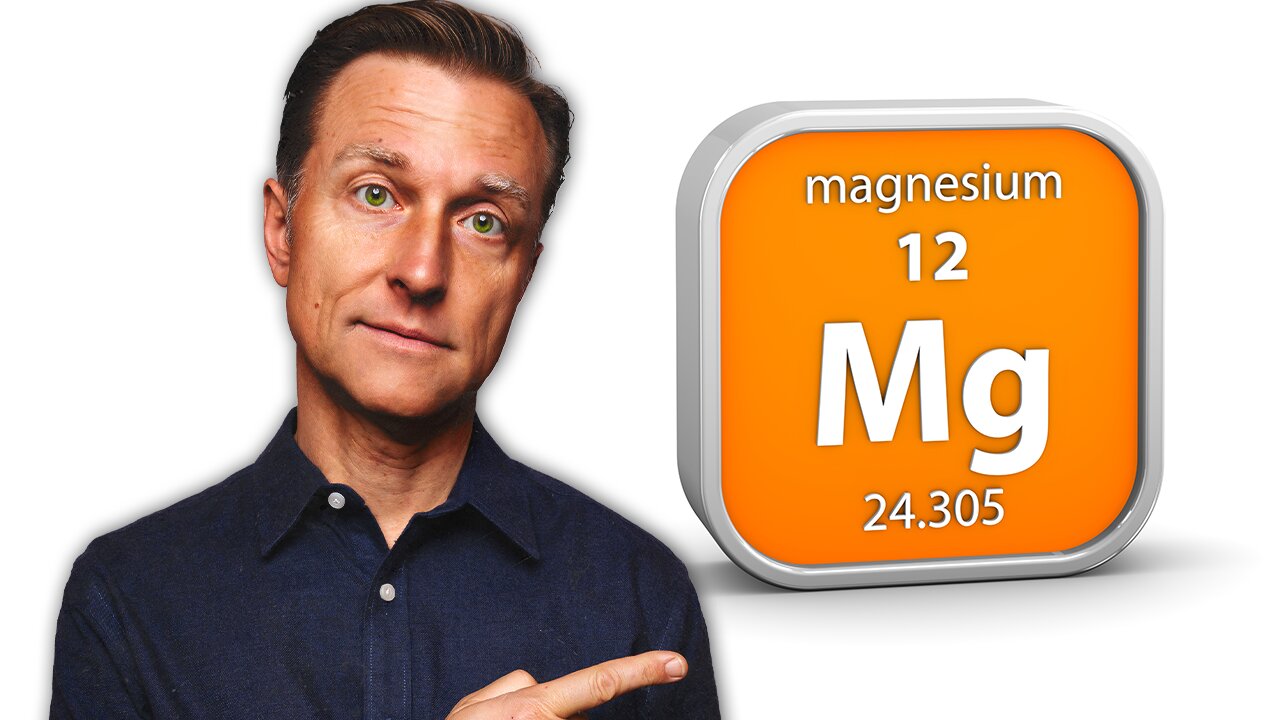Premium Only Content

First Sign of a Magnesium Deficiency NEVER to Ignore
Don't ignore this early sign of magnesium deficiency—plus 21 other important early signs!
0:00 Introduction: Important signs and symptoms of magnesium deficiency
0:59 What causes magnesium deficiency?
2:10 Foods high in magnesium
3:56 Signs of a magnesium deficiency
4:59 The earliest sign of a magnesium deficiency
Today, I’m going to share 22 signs of a magnesium deficiency. Sixty percent of magnesium is in the bone, 20% is in the muscle, 19% is in the soft tissue, and 1% is in the blood.
Magnesium deficiency is the most overlooked deficiency because it cannot be detected by a blood test.
The top causes of magnesium deficiency include:
• Consumption of sugar and refined carbs
• Alcohol consumption
• Cirrhosis of the liver
• NPK fertilizer leads to crops that are low in magnesium
• Malabsorption from gut inflammation
• Diuretics
• PPIs
• Gastric bypass surgery
• Low vitamin D
• Inflammation
Diabetes, high blood pressure, arthritis, osteoporosis, and cardiovascular disease are all associated with low magnesium.
The best sources of magnesium are leafy greens, almonds, and dark chocolate, but some of these foods contain oxalates. Oxalates block the absorption of magnesium. Meat, cheese, and shellfish contain magnesium and do not contain oxalates.
Here are 22 surprising signs of magnesium deficiency:
• Anxiety
• Insomnia
• Depression
• Migraines
• Restless legs syndrome
• Muscle cramps
• Fatigue
• Tourette's syndrome
• Oxidative cholesterol
• High homocysteine levels
• High blood pressure
• Calcification of the arteries
• Arrhythmias
• Stroke
• Metabolic syndrome
• Polycystic ovarian syndrome
• Kidney stones
• Higher levels of calcium in the blood
• Inflammation
• Nystagmus
• Asthma
Neuromuscular excitability, or tetany, is the number 1 earliest sign of a magnesium deficiency. Tetany is a twitching of the muscles, often affecting the left eye.
Magnesium is required for proper nerve function. When you’re deficient, the nerves become more excited, leading to faster nerve impulses.
Dr. Eric Berg DC Bio:
Dr. Berg, age 58, is a chiropractor who specializes in Healthy Ketosis & Intermittent Fasting. He is the author of the best-selling book The Healthy Keto Plan and is the Director of Dr. Berg Nutritionals. He no longer practices, but focuses on health education through social media.
Follow Me On Social Media:
Facebook: https://bit.ly/FB-DrBerg
Instagram: https://bit.ly/IG-DrBerg
Anchor: https://bit.ly/Anchor-DrBerg
TikTok: https://bit.ly/TikTok-DrBerg
Disclaimer:
Dr. Eric Berg received his Doctor of Chiropractic degree from Palmer College of Chiropractic in 1988. His use of “doctor” or “Dr.” in relation to himself solely refers to that degree. Dr. Berg is a licensed chiropractor in Virginia, California, and Louisiana, but he no longer practices chiropractic in any state and does not see patients so he can focus on educating people as a full-time activity, yet he maintains an active license. This video is for general informational purposes only. It should not be used to self-diagnose and it is not a substitute for a medical exam, cure, treatment, diagnosis, prescription, or recommendation. It does not create a doctor-patient relationship between Dr. Berg and you. You should not make any change in your health regimen or diet before first consulting a physician and obtaining a medical exam, diagnosis, and recommendation. Always seek the advice of a physician or other qualified health provider with any questions you may have regarding a medical condition.
#keto #ketodiet #weightloss #ketolifestyle
Thanks for watching! I hope this helps you understand how to spot a magnesium deficiency. I’ll see you in the next video.
-
 8:22
8:22
Dr. Eric Berg
9 days agoYour Body’s Urgently Trying to Tell You Something
6.09K8 -
 LIVE
LIVE
FreshandFit
9 hours agoShannon Sharpe Fired By ESPN! W or L?
11,684 watching -
 2:18:29
2:18:29
Badlands Media
11 hours agoDevolution Power Hour Ep. 376
113K26 -
 37:46
37:46
Stephen Gardner
9 hours ago🔥Trump NEVER expected THIS WIN as Schumer has EPIC MELTDOWN!
12.3K27 -
 2:02:41
2:02:41
Inverted World Live
5 hours agoNASA Engineer Says Trillions of Shape-Shifting, Cloaked Devices are Hidden on Earth| Ep. 83
15.9K8 -
 3:12:37
3:12:37
TimcastIRL
5 hours agoGOP Councilman DOUSED IN GAS, Set ON FIRE In Virginia, Suspect In Custody | Timcast IRL
215K76 -
 2:32:23
2:32:23
The Quartering
5 hours agoOn To The Big Bosses! Act 2 Of Expedition 33
44.9K4 -
 LIVE
LIVE
SpartakusLIVE
7 hours agoTiger Blood RESTOCKED and 30% off w/ code SPARTAKUS30
487 watching -
 24:58
24:58
Law&Crime
7 hours ago $1.38 earnedSecond Note Leaves Disturbing Clues in New York City Killings
22.3K9 -
 1:36:57
1:36:57
Badlands Media
23 hours agoAltered State S3 Ep. 39: Earthquakes, Energy Games & the Fall of the Narrative
62.8K13